Go offline with the Player FM app!
Where do the Foodland ravens roost?
Manage episode 418653886 series 1457379
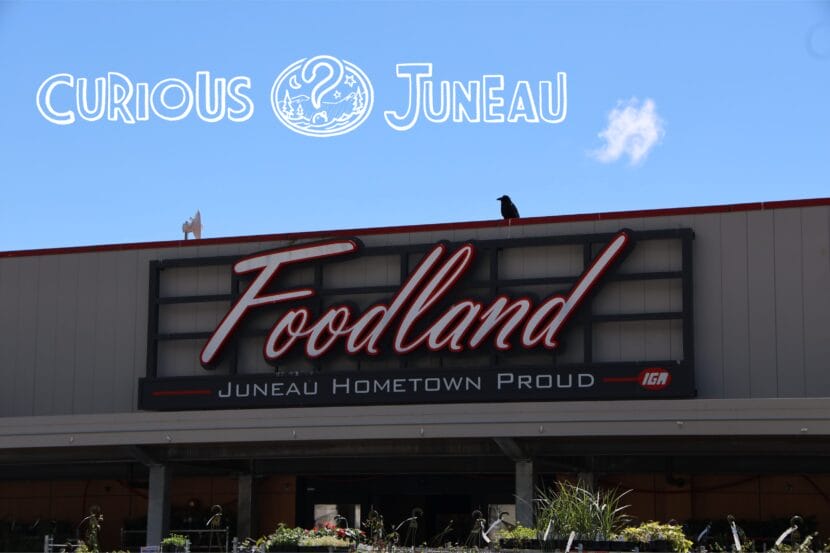
Marc Wheeler lives in downtown Juneau, close to the Foodland grocery store. He often stops there for lunch. That’s when he sees the parking lot’s resident ravens.
“I’ll be like walking while I eat it, and they’ll literally follow you like a gang of thugs,” Wheeler said. “Cause they’re just counting on you dropping something.”
Like many Juneauites, Wheeler has had a lot of fun watching the curious corvids that wander around town, but he noticed that most of them disappear at sundown.
“Where’s the roost?,” Wheeler asked for this installment of Curious Juneau. It took some nighttime detective work to find out.
The first lead came from Bob Armstrong, a naturalist and wildlife photographer who has been working in Juneau for more than 60 years.
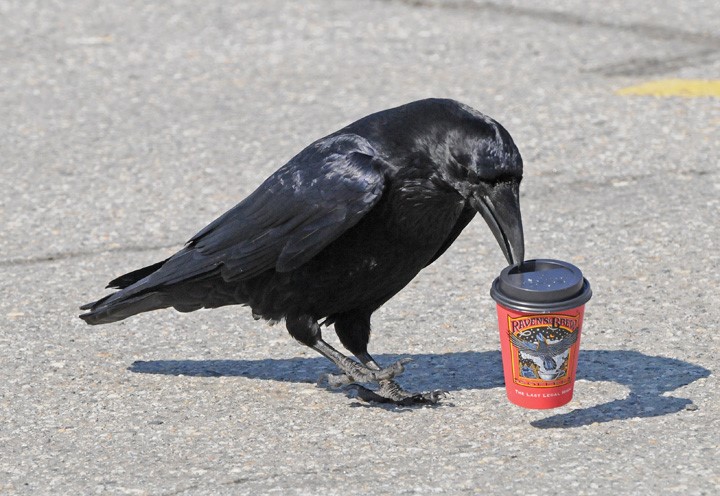
He’s photographed hundreds of ravens. One of his favorite shots from Foodland shows a bird with a bright red cup of Raven’s Brew coffee. The picture was carefully staged.
“I came into the parking lot and just put some latte in it and just set it up 20 feet away from the car and just sat there and waited,” Armstrong said.
Within a few minutes, a half dozen birds started circling it. Eventually, one took the lid in its beak and lifted the cup to show off an illustrated raven with its wings outstretched.
“But then what surprised me is it opened the lid of the cup – it had to snap it off – and then drank the latte that was in there,” he said.
Ravens are scavengers, meaning they spend their days looking for something — anything — to eat. Insects, berries, eggs paired with trash from the landfill and lattes.
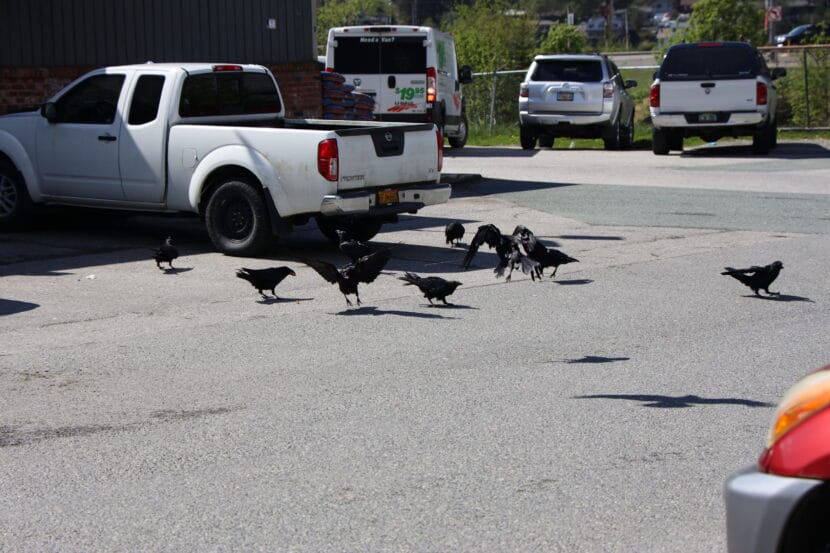
That explains why they hang out near Foodland looking for scraps. But their roosting habits are more mysterious. Despite decades of observation, Armstrong couldn’t tell me where ravens go at bedtime. Tracking them precisely would probably require tagging them.
Scientists in Fairbanks have used radio-transmitter tags to track urban ravens on a forty mile commute to their roosts in spruce trees outside the city.
KTOO doesn’t have the budget for radio transmitters. At least, not that kind of radio transmitter. So this study would need to be more low-tech.
Armstrong did have one idea. He suggested the spruce trees on Willoughby Avenue.
“Because if I go to Bullwinkle’s for pizza at night or something and come out at night, and then walk along that sidewalk there, I hear a lot of ravens talking from the trees in total darkness,” he said.
A rainy Tuesday night stake-out revealed no ravens in the trees. But there was some evidence in the echoey, dimly lit parking garage of the State Office Building.
The first sign of ravens were spikes along the railing, installed by people to keep birds out. Clearly, they didn’t work well, because the concrete railing on the garage’s third floor was covered in white bird poop, and there were a few black feathers left behind in the parking spaces.
The most significant clue was a nest, about a foot across, that was nestled in a few U-shaped pipes in a corner of the garage. It appeared empty, but it was a sure sign of raven residency.
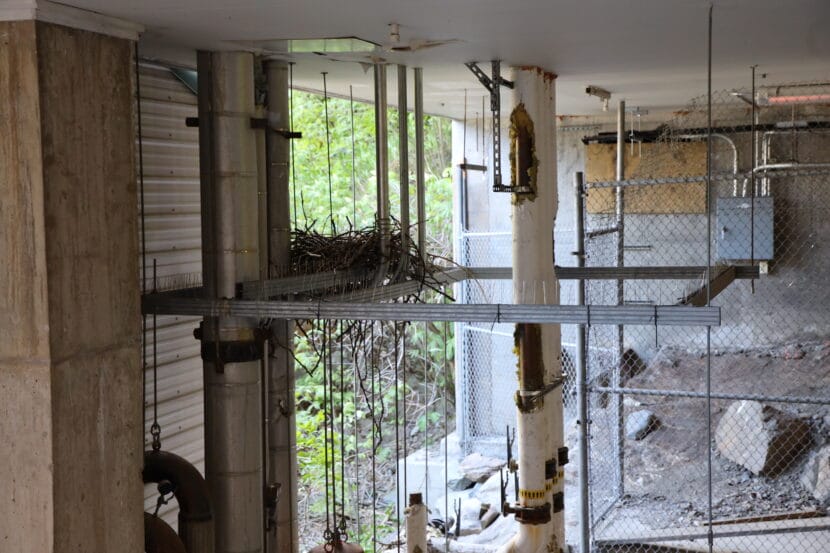
To find a raven roost, one must get inside the mind of the bird. John Marzluff, a retired professor of wildlife science at the University of Washington, has spent his career doing just that. He’s a corvid expert who has studied crows, jays and ravens.
“There are kind of two strategies in a raven society,” Marzluff said.
The first is for the older breeding pairs. Mates roost together.
“Those birds typically roost in a pretty consistent place on their territory, night after night after night,” Marzluff.
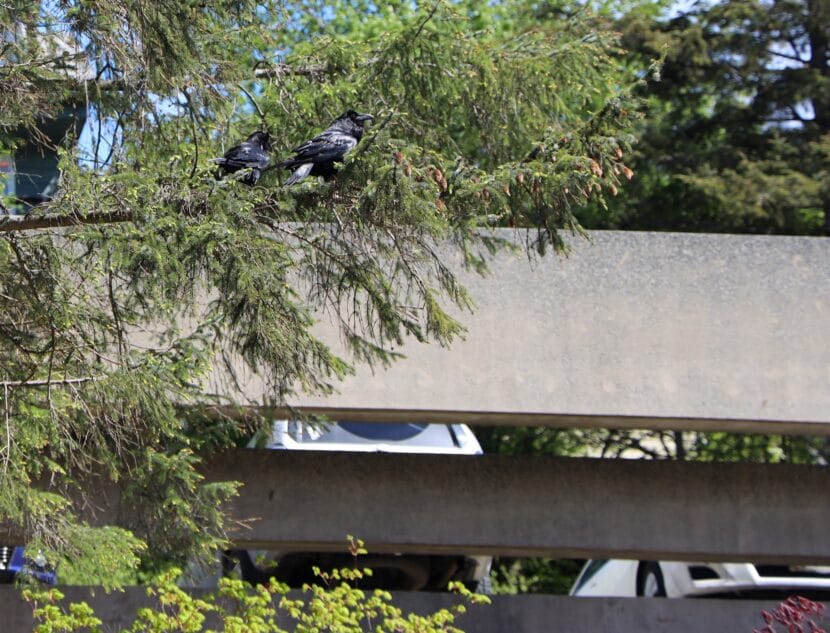
They’re fiercely protective of that territory, especially when they’re tending to a nest like the one in the parking garage.
“The rest of raven world are what we call vagrant non-breeders,” Marzluff said.
Those ravens are the most low-ranking in the bunch. They aren’t tied to a particular spot that they’re defending or returning to every day.
“They may aggregate at rich food sources like Foodland,” Marzluff said. “But it’s not the same birds every day, you know, day in and day out. To say that there’s a flock or a group that’s the “Foodland ravens” — probably not the case.”
They’re just ravens that happen to be at Foodland.
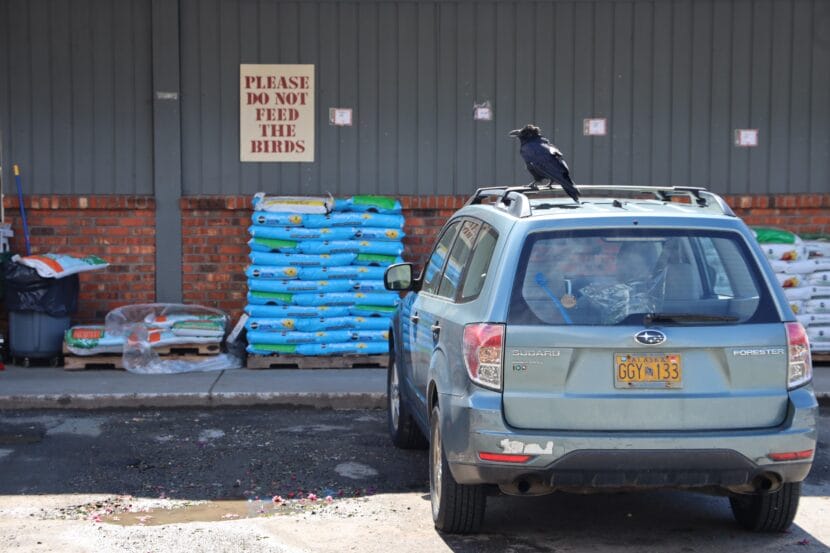
And that makes sense because ravens move around a lot to follow food. Marzluff’s research has shown that they travel thousands of square miles for their next meal. They’re flexible based on the changing seasons and the surprise delicacies that might appear.
“If all sudden there’s a big spill of a bag of dog food at Foodland, that word is gonna get out,” Marzluff. “Because the birds that are there will be very active and other birds will hear or see them and come in.”
Marzluff research has revealed that ravens, especially the vagrant non-breeders, use their roost as an “information center.” They’ll meet up with dozens or even hundreds of ravens to “talk” about food sources or predator threats that they encountered during the day.
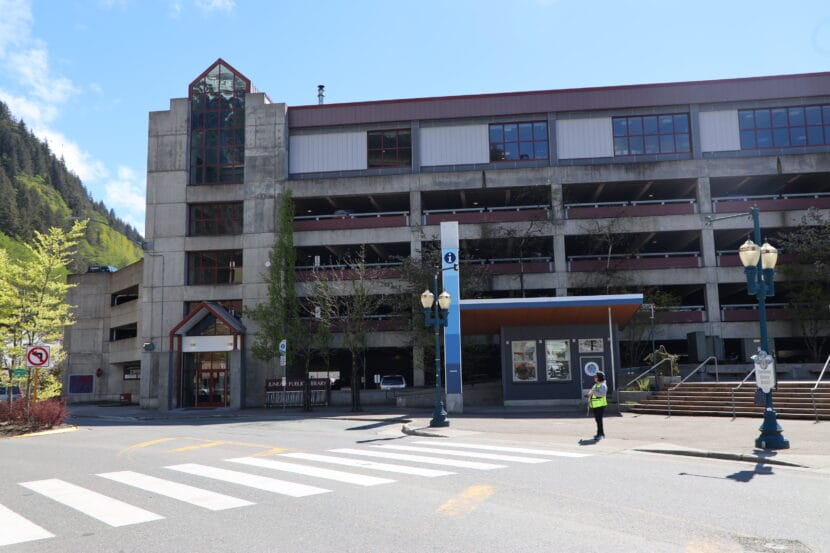
These roosts are typically found in tree stands or on cliffs, but in an urban environment that might change. A parking garage, for instance, is usually close to easy food.
“It’s also warm, and it’s also sheltered from the elements, and maybe even a little bit lighter so they can see any oncoming potential predator,” Marzluff said. “It might just be the perfect place.”
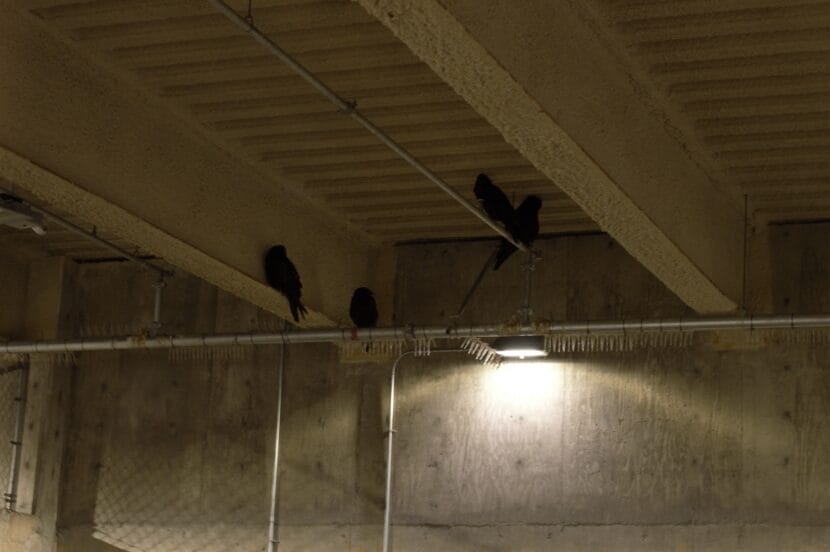
While the State Office Building’s parking garage was empty, the parking garage of the downtown library turned out to be a jackpot just past 10 p.m. on a Thursday night.
One the top level, 13 ravens – a superstitious grouping – perched on the lamps, pipes and crevices in the ceiling.
They declined an interview, which makes sense. It’s pretty rude for a reporter to break into their home while they’re sleeping.
20 episodes
Manage episode 418653886 series 1457379

Marc Wheeler lives in downtown Juneau, close to the Foodland grocery store. He often stops there for lunch. That’s when he sees the parking lot’s resident ravens.
“I’ll be like walking while I eat it, and they’ll literally follow you like a gang of thugs,” Wheeler said. “Cause they’re just counting on you dropping something.”
Like many Juneauites, Wheeler has had a lot of fun watching the curious corvids that wander around town, but he noticed that most of them disappear at sundown.
“Where’s the roost?,” Wheeler asked for this installment of Curious Juneau. It took some nighttime detective work to find out.
The first lead came from Bob Armstrong, a naturalist and wildlife photographer who has been working in Juneau for more than 60 years.

He’s photographed hundreds of ravens. One of his favorite shots from Foodland shows a bird with a bright red cup of Raven’s Brew coffee. The picture was carefully staged.
“I came into the parking lot and just put some latte in it and just set it up 20 feet away from the car and just sat there and waited,” Armstrong said.
Within a few minutes, a half dozen birds started circling it. Eventually, one took the lid in its beak and lifted the cup to show off an illustrated raven with its wings outstretched.
“But then what surprised me is it opened the lid of the cup – it had to snap it off – and then drank the latte that was in there,” he said.
Ravens are scavengers, meaning they spend their days looking for something — anything — to eat. Insects, berries, eggs paired with trash from the landfill and lattes.

That explains why they hang out near Foodland looking for scraps. But their roosting habits are more mysterious. Despite decades of observation, Armstrong couldn’t tell me where ravens go at bedtime. Tracking them precisely would probably require tagging them.
Scientists in Fairbanks have used radio-transmitter tags to track urban ravens on a forty mile commute to their roosts in spruce trees outside the city.
KTOO doesn’t have the budget for radio transmitters. At least, not that kind of radio transmitter. So this study would need to be more low-tech.
Armstrong did have one idea. He suggested the spruce trees on Willoughby Avenue.
“Because if I go to Bullwinkle’s for pizza at night or something and come out at night, and then walk along that sidewalk there, I hear a lot of ravens talking from the trees in total darkness,” he said.
A rainy Tuesday night stake-out revealed no ravens in the trees. But there was some evidence in the echoey, dimly lit parking garage of the State Office Building.
The first sign of ravens were spikes along the railing, installed by people to keep birds out. Clearly, they didn’t work well, because the concrete railing on the garage’s third floor was covered in white bird poop, and there were a few black feathers left behind in the parking spaces.
The most significant clue was a nest, about a foot across, that was nestled in a few U-shaped pipes in a corner of the garage. It appeared empty, but it was a sure sign of raven residency.

To find a raven roost, one must get inside the mind of the bird. John Marzluff, a retired professor of wildlife science at the University of Washington, has spent his career doing just that. He’s a corvid expert who has studied crows, jays and ravens.
“There are kind of two strategies in a raven society,” Marzluff said.
The first is for the older breeding pairs. Mates roost together.
“Those birds typically roost in a pretty consistent place on their territory, night after night after night,” Marzluff.

They’re fiercely protective of that territory, especially when they’re tending to a nest like the one in the parking garage.
“The rest of raven world are what we call vagrant non-breeders,” Marzluff said.
Those ravens are the most low-ranking in the bunch. They aren’t tied to a particular spot that they’re defending or returning to every day.
“They may aggregate at rich food sources like Foodland,” Marzluff said. “But it’s not the same birds every day, you know, day in and day out. To say that there’s a flock or a group that’s the “Foodland ravens” — probably not the case.”
They’re just ravens that happen to be at Foodland.

And that makes sense because ravens move around a lot to follow food. Marzluff’s research has shown that they travel thousands of square miles for their next meal. They’re flexible based on the changing seasons and the surprise delicacies that might appear.
“If all sudden there’s a big spill of a bag of dog food at Foodland, that word is gonna get out,” Marzluff. “Because the birds that are there will be very active and other birds will hear or see them and come in.”
Marzluff research has revealed that ravens, especially the vagrant non-breeders, use their roost as an “information center.” They’ll meet up with dozens or even hundreds of ravens to “talk” about food sources or predator threats that they encountered during the day.

These roosts are typically found in tree stands or on cliffs, but in an urban environment that might change. A parking garage, for instance, is usually close to easy food.
“It’s also warm, and it’s also sheltered from the elements, and maybe even a little bit lighter so they can see any oncoming potential predator,” Marzluff said. “It might just be the perfect place.”

While the State Office Building’s parking garage was empty, the parking garage of the downtown library turned out to be a jackpot just past 10 p.m. on a Thursday night.
One the top level, 13 ravens – a superstitious grouping – perched on the lamps, pipes and crevices in the ceiling.
They declined an interview, which makes sense. It’s pretty rude for a reporter to break into their home while they’re sleeping.
20 episodes
All episodes
×Welcome to Player FM!
Player FM is scanning the web for high-quality podcasts for you to enjoy right now. It's the best podcast app and works on Android, iPhone, and the web. Signup to sync subscriptions across devices.




